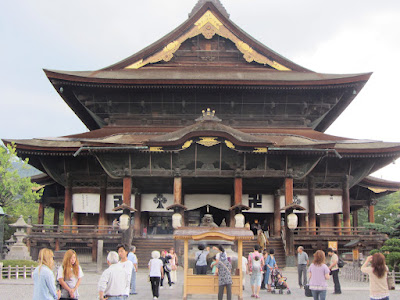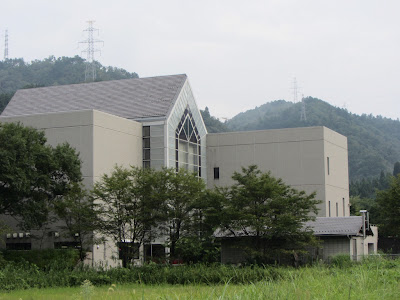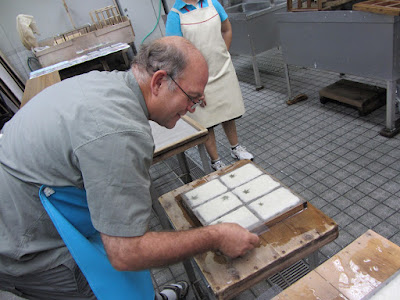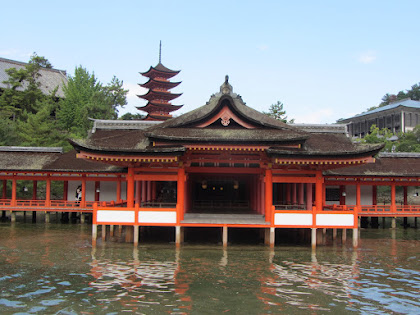Buddha's World became our world for several hours on Tuesday morning, as we toured the Zenkoji Buddist Temple. It dates back to 1707, and is designated a National Treasure! It is an active Buddist Temple, and in a daily ritual, without fail, the priests will come out and face the visitors (or visiting pilgrims) in the Main Hall to pray for their salvation, and that of the world.
The Zenkoji Temple retains the religious ferver of a functioning pilgrimage mecca. Many people come from all over the world to offer prayers here, and to be blessed by the priests. Clouds of incense smoke attest to the importance of this temple as an authentic place of worship! It is surrounded by gardens and ponds that encourage feelings of harmony and meditation. It is a very spiritual place for those who come to worship here.
Visitors will come to rub the worn figure of Binzuru, a physician and Buddha's most intelligent follower, hoping their own aches and pains will be alleviated! We didn't get a chance to rub Binzuru, but we should have!
When Doug was a missionary here, this Temple was in his area and he visited it several times. He wanted to take me below Zenkoji's Main Hall down into a pitch dark tunnel. The dark is meant to take away any light, making people become completely equal in their inability to see and represents hell. While walking through the dark tunnel, you are supposed to feel for a 'Key to Paradise' somewhere on the inside of the tunnel. It is very small and with NO light available, many people go through the tunnel never finding the key. As we continued down the tunnel, Doug said, 'here it is' and placed my hand on it. It didn't feel like a key but more like a door handle. It was so cool when Doug found it because then others began to place their hands on it. In the Buddha belief it is said that touching the key will guarantee 'Eternal Life'...can you imagine how excited those people were who actually touched it!
As we continued looking around the Temple, I heard an excited voice in Japanese saying something to me. Doug interpreted what they said...these ladies recognized us from the day before when we were up on the Tatayama Alpine Route, they were there too, and they were so excited that we were in the same place together again! I love the Japanese people, the are so kind and even small things can bring them great joy!
Tuesday afternoon, we took the train down to Kamakura, it is a resort city near the ocean. As we were walking to our hotel, we saw four LDS missionaries...we were so excited! We have been watching for them as we travelled throughout Japan! They were just going for dinner, so we asked if we could treat them, and of course that was OK with them! They took us to a great Hawaiian burger place. We had a good time visiting with them, they are great missionaries! Doug enjoyed telling them stories from his mission, one of the Elder's father's served in Japan the same time as Doug. It 's a small world!
Wednesday morning in Kamakura, we went to see the local Buddist Temple and Museum called Tsurugaoka Hachimangu. It is also an active Buddist Temple. It was so interesting for us to see the young adults living and working there.
After touring the Temple, it was time to catch the train to Tokyo. We had reserved tickets to the Sumo Tournament, and we had been looking forward to it for several weeks! As we got off the train and walked up to the Kogugikan Arena, there were banners everywhere celebrating the tournament!
We found our seats, which were cushions on the floor arranged in a six foot area. We had seats that were on the opposite side of the main presentation, but it gave us a good view of the wrestlers faces as they prepared. It was so interesting to see them psychologically prepare themselves before each fight! I was amazed how big these guys were!
We had arrived mid morning and there were bouts going on between new Sumo trainees that were yet to be officially ranked. The bouts begin from the lowest rank moving up in seniority to junior grade.
During a visit to the bathroom, I think I found the funniest thing on my whole trip to Japan...I had to tell Doug about it and then I just had to go back and get a picture. A push button 'flushing sound effect' box on the wall next to the toilet. It really works, I pushed it just for fun and it really sounds like a flushing toilet, it is to be used when you want to cover up any other personal sounds! So funny, the Japanese think of everything!!
After watching,the beginner Sumo wrestlers for several hours, we left the arena to go for lunch. As we walked around looking for something good to eat, we came across the Ganesh Indian and Nepali Restaurant. We went in and ordered butter chicken and chicken curry with naan bread, how fun it was to eat Indian food in the middle of Japan. These two guys, one from Nepal and the other from India, are trying to sell Indian food to the Japanese! We hope it goes well, the food was so delicious!!
On our way back to the Arena we saw a couple of the Sumo wrestlers going for lunch, too. Wouldn't this make a great ad for McDonald's?
Well, we needed to get back to the Sumo Arena by 2:00, because that was when the real Sumo wrestlers started to arrive. The 'Juryo' Division wrestlers are young hopefuls aiming for higher division rankings. Fights in this rank and above are considered full fledged salaried professionals.
Then the 'Makuuchi' wrestlers from the Senior Division step into the ring, with their ceremonial aprons on, which cost $50,000-$60,000 a piece!
After they finish, 'The Grand Champion' or 'yokozuma' makes a ceremonial entrance. He claps his hands and stomps his feet drawing excited calls of 'yoisyo' from the crowd. There is only ONE 'yokozuma' in the world today!! This is him...In the past three hundred years since the title was created, only sixty nine Sumo wrestlers have been so honored.
To become a Grand Champion, or 'yokozuma', he must win two consecutive tournaments while holding the rank of 'ozeki' (the highest rank), and has proven himself to be a man of character worthy to hold such an exalted position. He was so honored at this tournament. He is very wealthy, and will earn several million dollars at this tournament alone!
Many of these Senior Sumo Wrestlers are millionaires, they make very good money! Kinda like hockey players in Canada!
Then, after the Grand Champion's entrance, battles between the highest division wrestlers begin, with the bouts featuring the wrestlers at the top rank at the end with the Grand Champion fighting the last fight of the day!
We were truly entertained watching these massive Sumo wrestlers, they are so big, but still strong and powerful! Sumo wrestling is the national sport in Japan, so we were glad that a tournament was happening while we were here! There are only six tournaments a year!
Well, we are staying in Tokyo tonight, our last night in Japan...I am so sad to leave. This has been such a wonderful experience for both of us!
Tonight, we just went to the 7-11 and picked up a few things for dinner. Doug got a corn dog, because he always had them on his mission. I went for the potato wedges, but when we checked out we could have easily had octopus!! It was for sale right there on the counter! Maybe if I lived here a little longer, I would learn to love it, but not just yet!



















































